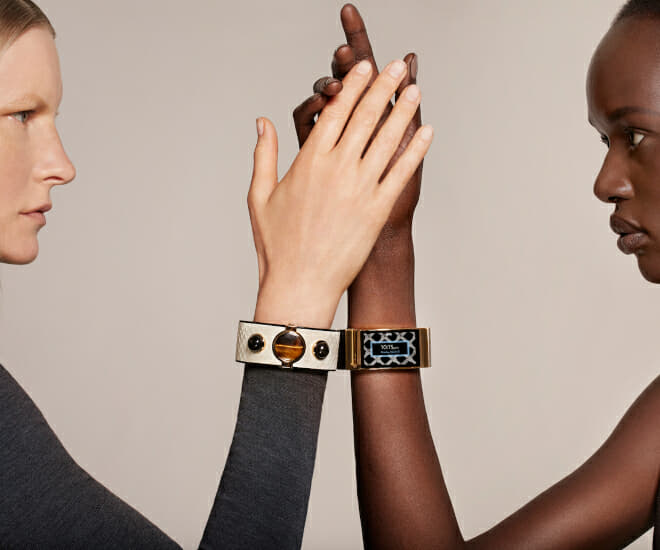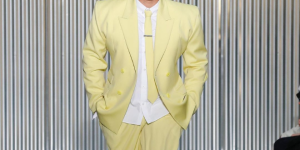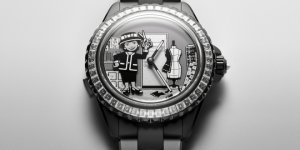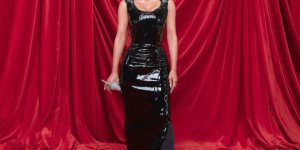The Merge Between Fashion and Functionality: Wearable Tech
Today’s digital adoption sees luxury brands delving into the world of wearable tech to develop products that are both fashionable and functional.

Fashion and technology are two different spheres that have been brought together when the first calculator watch was introduced in the mid 1970s. Since then, wearable technology has only been growing, entering not only the accessories sector but clothing and footwear. Nowadays, luxury companies are rethinking their approach to tech-based fashion, and today’s digital adoption and consumer readiness are fast-tracking the wearables industry to hit US$6.5 billion by 2027. From the US$15,000 diamond-clad DeGrisogono rendition of the Samsung Gear S2 Smartwatch to Louis Vuitton’s in-house connected Tambour timepiece, luxury brands are making their mark in the smart tech space.
A more recent example, Gucci’s foray into the tech world sees them collaborating with Oura, a smart ring brand that’s managed to find a market of more than 300,000 wearers to date because of its impressive tech. Gucci X Oura monitors a number of metrics — including heart rate, body temperature, oxygen levels and movement — to calculate three daily scores: Sleep, Activity and Readiness. It’s a comprehensive health consultant packaged into a device the size and shape of a standard wedding band. Oura sells the same Generation 3 ring in silver on its website, the Gucci rendition just comes in black PVD titanium with details and the brand’s logo in gold tone; it’s a combination of style and smart tech. Appearance aside, the Oura Generation 3 and the Gucci x Oura rings are identical, which begs the question, why is there such a demand for fashionable wearable technology?

Well, Oura believes that what one wears also impacts how a person feels. The Oura technology is already established, but it has become a more attractive wearable device with Gucci’s style. This is fashion and function together. Oura’s chief operations officer Michael Chapp said, “Oura has always held a firm belief that wearables can be both innovative and stylish. With this collaboration, we’re hoping to elevate our design and appeal to more audiences.”
The Merge Between Fashion and Functionality

There’s always been an interest in the world of fashion in the practicalities and possibilities of new ideas, so it’s not a surprise that new wearable tech trends are being explored by the fashion industry. From dystopian-inspired innovations to tech and fashion brand collaborations, the constant blurring of boundaries between design and smart technology is ever-present.

- READ MORE: TAG Heuer Connected Calibre E4: Winning Form
This marriage between design and functionality are often seen in watch brands. TAG Heuer’s latest Connected Calibre E4 watch combines elegance and craftsmanship with new high-tech features that focuses on an immersive sports experience. It works with the TAG Heuere Sport app and provides detailed tracking for golf, running, cycling, walking and fitness sessions thanks to the watch’s built-in GPS and heart-rate monitor. “The TAG Heuer Connected watch was designed and engineered with the same passion and attention to detail as our mechanical watches. The Connected watch is not only a beautiful timepiece, it’s a truly immersive experience, as it now sits within a complete TAG Heuer digital ecosystem geared towards performance and sports. It expresses the brand in a completely new way and offers limitless possibilities in terms of innovation for the future and will lead the way into a new era for TAG Heuer.” states TAG Heuer’s chief strategy and digital officer, Frédéric Arnault. The smart features of the watch is combined with the elegance of a chronograph-inspired timepiece crafted in the purest watchmaking tradition, with a 45-mm case in materials like stainless-steel titanium, ceramic or sapphire crystal, subtle polishes and interchangeable strap choices.

Hublot also had a foray into wearable technology with their luxury smartwatch, the Big Bang E Titanium 42, which folds connected tech into one of the 21st century’s most recognisable watch designs. The Big Bang E builds on that platform and is part of LVMH’s larger push into high-end smartwatches, it’s regarded as the new incarnation of the brand’s Art of Fusion ethos: a fusion between tradition and innovation, cutting edge materials and the latest digital technology. Equipped with the latest technological developments available for wearable technology, the Big Bang E Titanium comprises of 42 components and is powered with Wear OS by Google. The wearer can access apps on Google Play, get answers on the go with Google Assistant and make fast simple payments with Google Pay. It features exclusive interpretations of traditional watch complications, such as the Perpetual Calendar with an immaculately precise moon phase or a second GMT time zone, and enhanced to take advantage of the possibilities offered by the digital world. The result is a more traditional wristwatch wearing experience that includes the expressive nature of wearable technology.
Nike’s chief talent scout, Michael Leming states that “With aesthetics being as important as the devices these days, tech execs are hiring fashion powerhouses in the hopes that their new partners will bring their taste with them. Leaders have to be more broadly skilled than before: they have to be able to respond to a customer base that wants tech and fashion in one package.”

- READ MORE: Montblanc reveals line of smartwatches
The mindset of technology and fashion fusing is not an uncommon one. In 2015, with the release of the original Apple Watch, it was revealed that Apple had partnered up with luxury goods maker Hermés. At that time, Fitbit and Pebble were the main players in the smartwatch industry, but with the release of the Apple Watch alongside the iconic collaboration, the two experts offered consumers the best of technological and traditional craftsmanship. The goal was to create a product that will attract both tech and high-fashion audiences. As a result, the wearing of the watch didn’t just mean that you were a tech-fan but it became a powerful fashion statement.
One thing is for sure, we have a lot to look forward to in terms of wearable tech. No matter the fashion-tech collaboration, there is a simple theme to bring the product to market: design for the user. It’s not enough to be fashionable or technically savvy, consumers want both.
For more fashion reads, click here.







